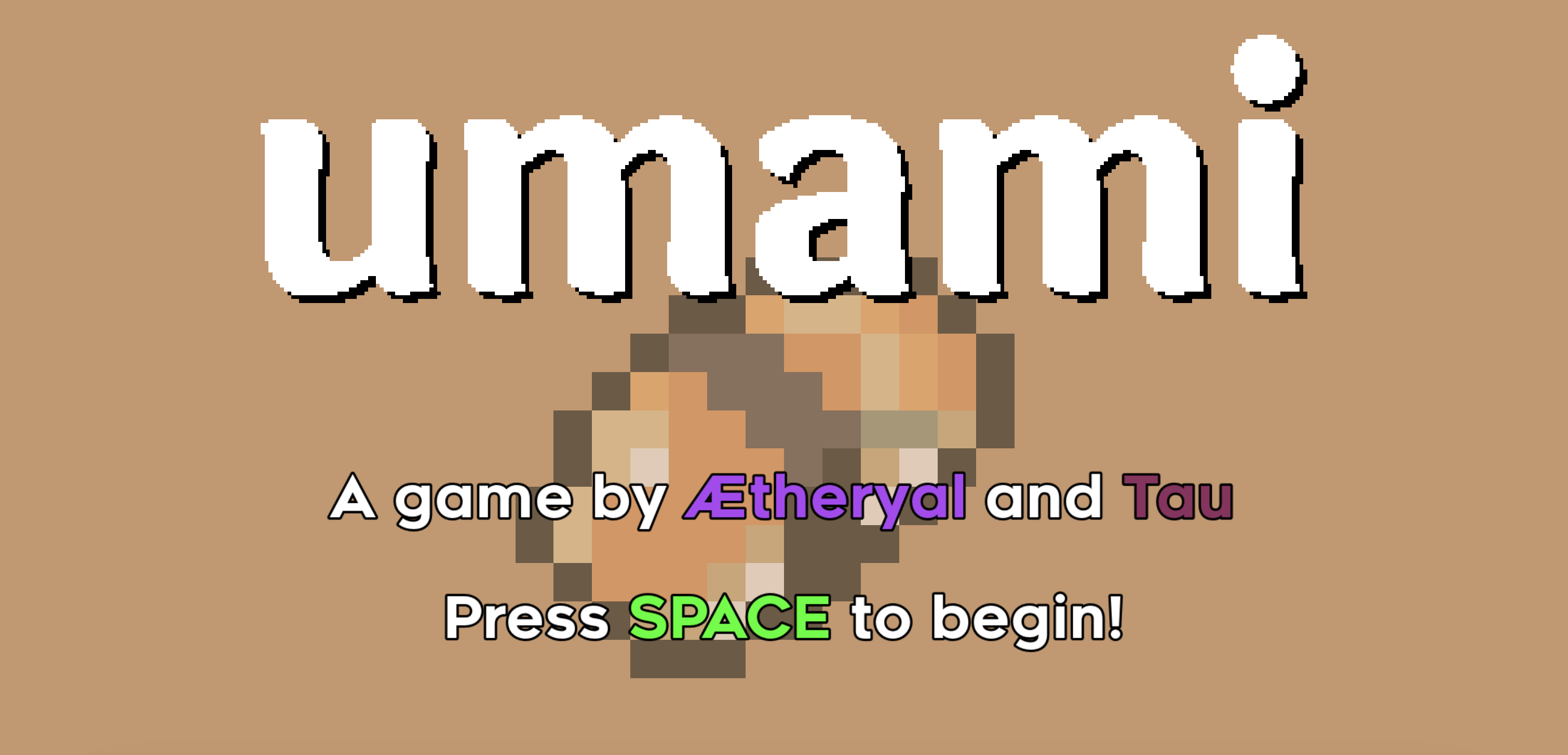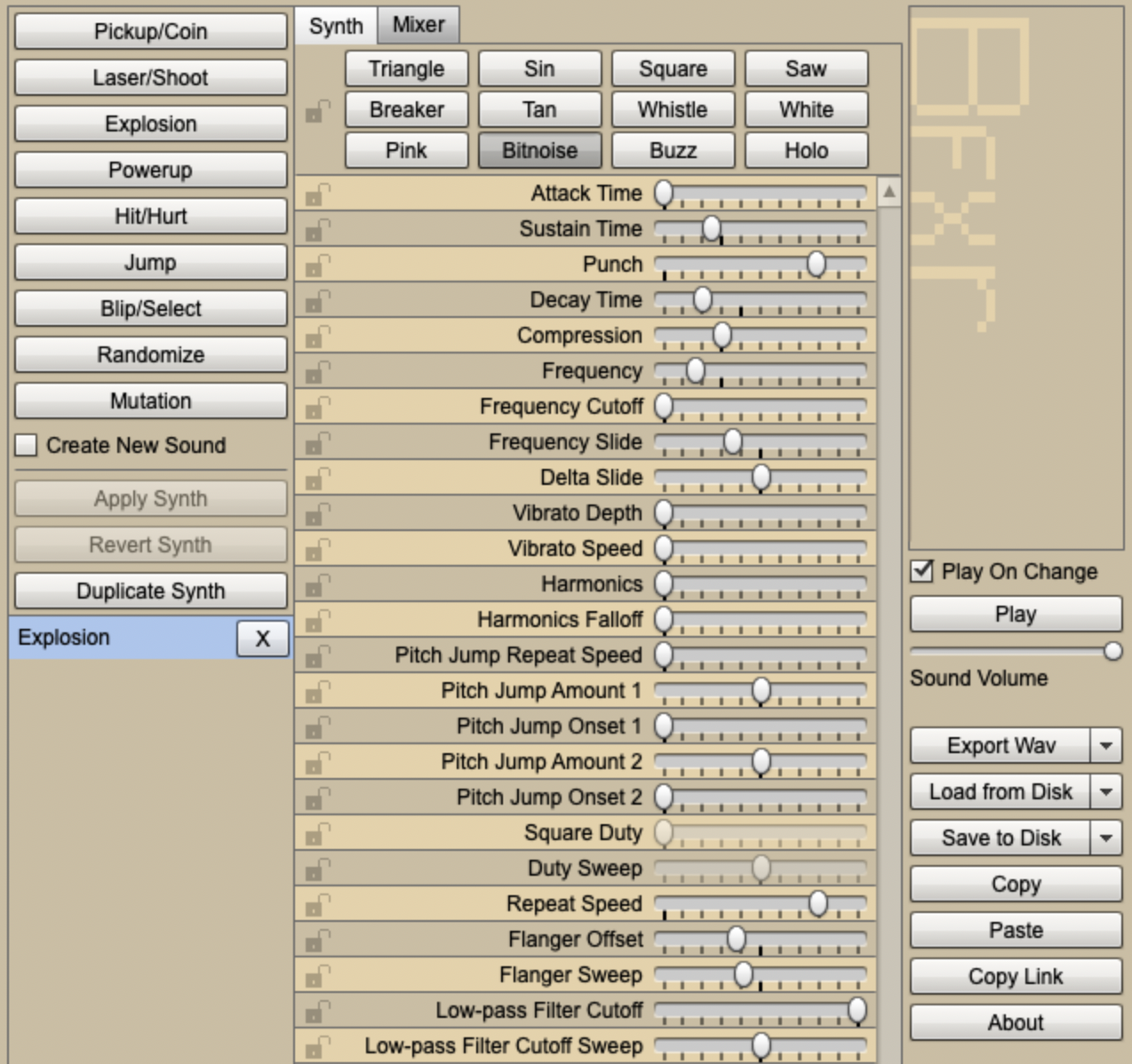The story so far . . .
In the summer of 2024, I participated in the Game Maker’s Toolkit Game Jam, a 96-hour blitz of coding and content creation. The result was Umami, a short puzzle game about moving sushi around on conveyor belts, created in collaboration with fellow developer Ava Simon. The game ended up being rated in the top 10% of submissions in the overall category. As part of the game jam, I also wrote an original dynamic soundtrack to accompany the gameplay. I also used several sounds that I had developed for a previous project. Here, I wanted to offer some insight into how the music and sounds of Umami were created, as well as discussing some of the more technical elements of the soundtrack.

Game Loop
The main game loop consists of a percussion pattern with a bassline in F major. As different ingredients are deployed, the music changes in density as more layers are added on top.
The drums and bass suggest a laid-back Bossa Nova groove. Bossa Nova is a genre with a rich and contested history of cultural exchange. In the context of video games specifically, Bossa Nova is closely associated with the Nintendo Wii, and more specifically the music for the Wii Shop Channel and the Mii Channel Plaza.
Layers
The Main Loop
While the intro uses three layers of drums (a hi-hat/shake, a snare drum, and a kick drum), the main loop uses only two; the bass synth fills the role of both bass and kick drum.
Bongos (Rice)
Bongos are not a traditional Brazilian instrument; a more regionally accurate option might be a caixa. Since rice is included in every puzzle, this is the most consistent element of the “machine running” portion of the game, and since the game doesn’t have any conveyor belt sounds, the faster, almost “mechanical” rhythm doubles as a representation of a diegetic sound in a kind of musical onomatopoeia.
Marimba (Fish)
The marimba outlines the harmony, including upper extensions (mostly 6ths and 9ths) with a couple of chromatic passing chords add character. The rhythm is the partido alto, common to samba and other Brazilian musical styles. The part was originally conceived for guitar, but going through my library of sounds, I stumbled across a marimba sample from Chrono Trigger that fit nicely.
Pizzicato (Nori)
The pizzicato part is phrased in groups of 7. The idea is that because the harmony uses so many diatonic extensions, the pizzicato can remain relatively unchanged regardless of the underlying harmony. This sample also comes from Chrono Trigger, where it appears prominently in Yasunori Mitsuda’s Wind Scene.
Here’s an example of the basic loop, the bongos, the marimba, the pizzicato strings, and the full groove with all the parts added:
Implementation
How do you handle all of this?
In Godot, I created a scene called MusicController with a number of AudioStream2D nodes as children. Godot has a feature that allows you to autoload scenes at runtime that stay active regardless of any scene changes or reloads. MusicController is one of these scenes, and it means that scripts can reference it by name as /root/MusicController. Not the most elegant approach, since renaming the controller or accidentally deleting it will break basically everything, but for a game made in a weekend, it worked beautifully.
MusicController feeds into a bus in Godot’s built-in mixer (Oh, did I mention Godot has a built in mixer that can apply digital effects?) which controls the overall music volume.
Given a fixed tempo and a starting point on the beat, Godot has the ability to loop audio seamlessly. For a 16-bit soundtrack with no processing (e.g. no reverb that would trail over to the start of the next iteration of the loop), this is perfect and worked consistently, but created issues when uploading to itch.io’s servers. Because the audio sometimes took a moment to load, things would desync extremely quickly, and sometimes the loop would restart before it was finished playing.
There are some ways to improve this performance. In your project settings, make sure the audio buffer is set as low as possible, though be aware that too low can cause issues if the game runs slowly. If you are exporting for web, make sure you’ve enabled threading if your platform supports it. (Notably, itch.io does not, which is the main reason Umami has no web build at the present time).
The main way to improve this is using Godot’s built-in AudioStreamSynchronized . . . which I would have absolutely used if I knew it existed when I was working on this project. Ah, well. Hindsight 20/20.
Conveyor Belt Placement
The conveyor belt placing sound was left over from an old project where I created a catalogue of sounds for a fictional operating system. It had a satisfying enough “pop” that I thought it would provide almost tactile feedback for the player.
Godot includes a value called pitch_scale for its AudioStream components which allows you to adjust the pitch of sounds. One way to create more variation in a sound is to add slight deviations in pitch each time you play it.
Here is one possible implementation using GDScript:
const lb : float = 0.94
const ub : float = 1.06
func play_rand():
pitch_scale = randf_range(lb, ub)
play()
I’ve seen other implementations that prevent immediate repetitions of pitches that are too close to one another. I opted not to do this, since I was using only very small variations in pitch to begin with.
Reset Transitions
The reset transition sound was made using bfxr, an elaboration on the popular sfxr tool.

It's surprising to me that bfxr is such a popular tool given that it's an extremely guts-exposed synthesizer. I think context is key here. bfxr isn't being billed as a tool to make music in the way a synthesizer might be; it's being billed as a tool to make 8-bit sound effects. And you don't have to know what a duty cycle is to tweak the "Square Duty" slider and hear a difference in the sound. It's actually quite empowering, and I think more introductory music classes should introduce tools like this . . . but I digress.
The final game sound is slightly modified from bfxr's initial output with some shaping, delay, and reverb. Here's the original sound I made using bfxr with no modifications:
And here's the final sound as it appears in the game:
I want to give a huge thank you to Mark Brown of Game Maker’s Toolkit for organizing the game jam in the first place. It was a fantastic experience, and while I’m pleased with our game’s performance, it was always really an excuse to have fun and make something. And if you’ve made it here, thank you! It takes a lot of commitment to get this far into my ramblings. (I was inspired to make this write-up after seeing something similar by composer Lena Raine about her work on the game Celeste, so if you liked this, definitely check that out! She is much more coherent than I am.)